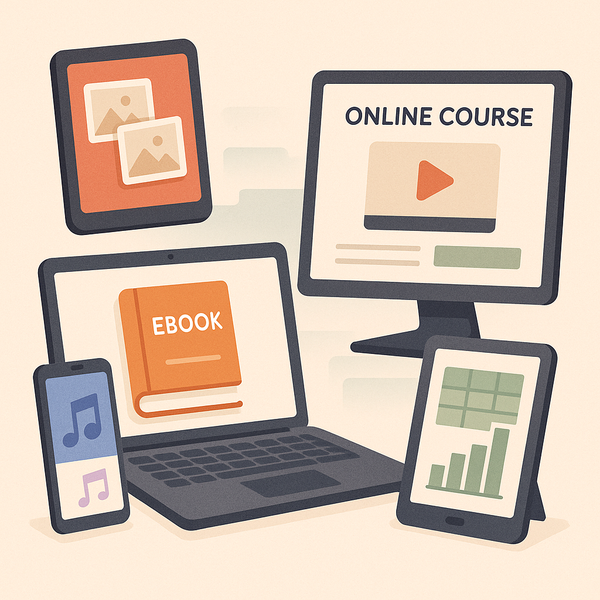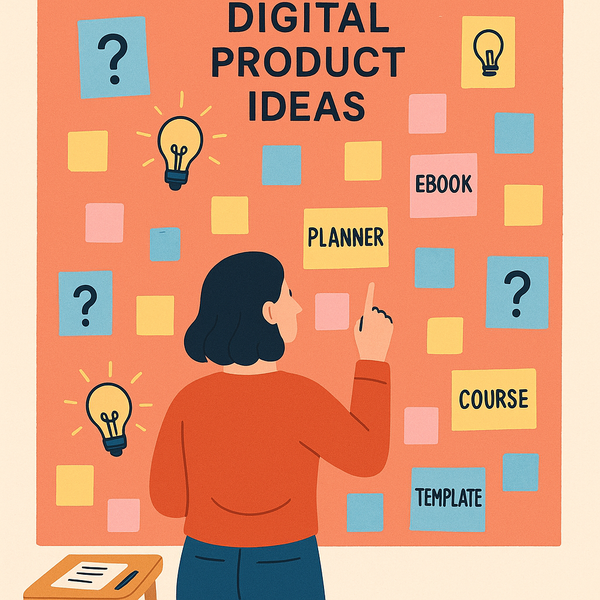Where to Sell Digital Products (Even If You’re Just Starting Out)

So, you’ve created a digital product—or you’re thinking about making one—and now you’re wondering, “Where do I actually sell this thing?”
First of all, congrats! That first step (coming up with a product idea and bringing it to life) is huge. But you’re right—knowing where to sell it is just as important. The good news? You’ve got options. Lots of them. And I’m here to break them down for you in a way that makes choosing one feel way less overwhelming.
Let’s walk through some of the best places to sell your digital products, especially if you’re just starting out.
1. Etsy – Perfect for Creative Products
If your digital product is even remotely creative—think planners, art prints, resume templates, Lightroom presets, or anything design-y—Etsy is an amazing place to start. People come here expecting to buy digital downloads, and the traffic is already built in.
Pros:
- Huge audience looking for exactly what you're selling
- Built-in trust (people already trust Etsy)
- Easy-to-use seller interface
Consider:
- You’ll pay small listing + transaction fees
- Competition can be fierce, so your visuals and keywords matter
2. Gumroad – Simple, Flexible, and Beginner-Friendly
Gumroad is like the chill friend of digital product platforms. You don’t need a website. You don’t need to code anything. Just upload your product, write a description, and share your link.
Pros:
- Super easy setup
- No monthly fees (you just pay a small percentage when you sell)
- Good for everything from eBooks to courses to software
Consider:
- Doesn’t have a built-in audience, so you’ll need to bring your own traffic
- Customization is limited unless you upgrade
3. Payhip – Like Gumroad, With a Bit More Flexibility
Payhip is another great option that works well for selling things like eBooks, online courses, coaching sessions, or printables.
Pros:
- Zero upfront costs (they just take a fee per sale)
- You can sell memberships, subscriptions, and even physical products
- Built-in VAT handling (great if you’re outside the U.S.)
Consider:
- You’ll still need to drive your own traffic
- The design is clean, but not flashy
4. Podia – Ideal for Courses, Webinars & Bundled Content
If your digital product is more course-based or community-oriented (think: video lessons, downloadable workbooks, coaching), Podia is worth checking out.
Pros:
- Built-in landing pages, email marketing, and checkout
- Great for bundling products together
- Looks professional without needing tech skills
Consider:
- Monthly fee starts at $0, but most features require a paid plan
- Not the best for quick one-off products like a single PDF
5. Your Own Website – More Work, More Control
This route takes a little more setup—but long term, it’s a powerhouse move. You can use platforms like:
- WordPress + WooCommerce
- Shopify (with digital download plugins)
- Ghost.org (if you’re writing blog-style content and want to sell on the side)
Pros:
- Full control over branding and customer experience
- No marketplace competition
- You own your audience (important!)
Consider:
- You’ll need to handle hosting, setup, and maybe even tech hiccups
- You’re responsible for bringing in all the traffic
6. Sell via Social Media + a Link Tool
If you’re just getting started and don’t want a whole storefront yet, you can also sell directly through Instagram, TikTok, or YouTube by combining them with a tool like Stan Store or Beacons.ai.
Pros:
- You can start selling right from your profile
- Easy to use, with mobile-friendly checkout
Consider:
- Works best if you’re already creating content
- Less robust than a full ecommerce platform
Final Thoughts: Start Simple, Grow Smart
If this all feels like a lot, here’s your takeaway:
- If you want built-in customers, try Etsy.
- If you want easy setup, go with Gumroad or Payhip.
- If you want long-term control, build a simple website or use a link-in-bio store.
You don’t need to pick the “perfect” place to sell. You just need to start. You can always evolve your setup later.
Got your product ready? Pick a platform, hit publish, and share it with the world.
And if you're still brainstorming your first product idea? Check out my last article on what kind of digital products people sell.
Want more step-by-step guides like this?
I send out helpful tips on building and selling digital products—designed especially for beginners—straight to your inbox.
Sign up for the newsletter and get practical advice, inspiration, and free resources to help you grow faster (without the overwhelm).




